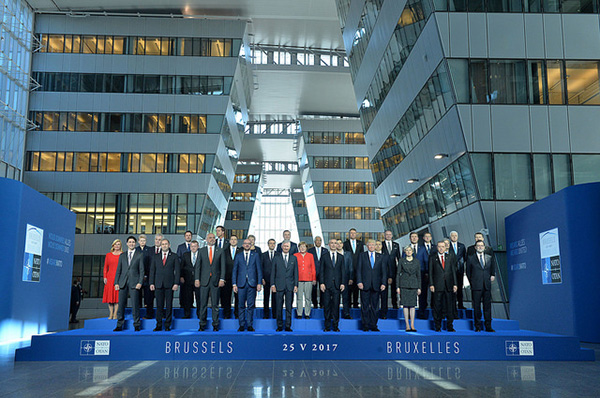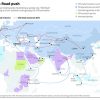
NATO does not like referring to fronts, because this would imply enemies. It prefers everything to be a matter of flanks: the Eastern flank (bordering Russia) and the Southern flank. But this has been superseded too. It is obsolete terminology and now there is talk of a 360º NATO, and scarcely even of ‘borders’ in the two quadrants, something Donald Trump referred to in Brussels. In other words, it looks in all directions. However, as shown with the attack in Manchester, the threat, the plague, emanates both from within and without in the case of a jihadist terrorism to which borders are meaningless. It is this threat that ensures the front has a 360º circumference and even extends inside the circle. The question is whether NATO is the right organisation for addressing the menace.
NATO is already cooperating in this area with its AWACS reconnaissance planes, in support of the international coalition against Islamic State (ISIS or Daesh) in the Middle East. Trump, at last week’s meeting (not summit –the next summit proper does not take place until 2019, to commemorate the 70th anniversary of this long-lasting Alliance–) with the allies advocated and secured NATO’s incorporation into the coalition. France and Germany, which see a limited role for NATO in the fight against terrorism and argue that its image in the Arab world, especially after the chaos of Libya, could prove counter-productive if it is a case of winning local people’s hearts and minds, had to have their arms twisted. It is a formality that changes little in reality: ‘It does not mean that NATO will engage in combat operations’ said Jens Stoltenberg, its Secretary General. Moreover, all the member states are already part of the coalition.
Trump has, fortunately, changed his stance on NATO. He no longer views it as ‘obsolete’, although the Alliance faces many challenges, ranging from cyber-threats to real military capabilities. The Internet is another new front in the fight against terrorism, as the G7 has highlighted. NATO’s image has improved on both sides of the Atlantic, including in Spain after going through a bad patch. Amid more unpredictable threats, the NATO culture has gone back to being dissuasive. This is clear in the case of Russia, even if NATO does not want to label it as an enemy. After Crimea, Ukraine and the pressures exerted on the Baltic States, NATO has rediscovered the language of dissuasion and defence vis-à-vis Moscow, although it wants to avoid any provocation. Within the ambiguity inherent in the concept, dissuasion involves talking about war and nobody wanting to wage it.
That said, in the case of jihadist terrorism it is worth asking how it is possible to dissuade people who are prepared to sacrifice themselves in order to kill, to inflict harm. It is impossible to dissuade against suicide terrorism, because dissuasion is based on the rationality of the participants. A different variety of preventive measure is needed, against terrorism and the causes of terrorism, as they say. Depriving Daesh, like al-Qaeda before it, of its most strategic and symbolic territorial base is important, but what comes next?
What is needed above all is coordination of the information services. In fact, NATO already has a new intelligence division, the Joint Intelligence and Security Division (JISD). And in Naples it has a hub for collecting intelligence and information about the South. How important is the South for NATO? In the East NATO extends as far as Afghanistan, and in the South to the Maghreb. Sub-Saharan Africa is somewhere that the US (and France and other countries) are currently concerning themselves with on their own account or as part of the EU. In any event, Spain is by no means a flank bordering the South (nor is it a rearguard, as it was in the Cold War). France meanwhile does not want NATO to be given extraordinary funding for the fight against terrorism.
The only time NATO has invoked its Article 5 (referring to mutual defence: an attack against one ally is an attack against all) was after the September 11 terrorist attacks in the US in 2001. And it was on this basis, over a considerable period, that justification for the allied action in Afghanistan was sought. The commitment to Article 5 is something that all US Presidents have unconditionally reaffirmed: until the arrival of Trump, who has resisted giving it his public and explicit support as President, after rejecting it as a candidate. It is a silence that became even more deafening in the words he uttered at the unveiling of a monument to 9/11 and Article 5 at the new NATO headquarters. The ambiguity on this commitment (another matter entirely is how an attack would be responded to) undermines the Alliance.
‘Projecting stability’ is the slogan for the approach towards the South. In other words, it is not so much a case of intervening militarily as strengthening local capabilities against destabilisation and building post-conflict institutions. Libya, for instance, has asked for help in setting up a Defence Ministry. NATO can only do so in cooperation with the EU, which has more experience in this area.
What holds for the East does not hold for the South. The threats are different. One is modern, the other pre-modern (with an advanced use of new technologies in conjunction with other older ones). Ultimately, despite the 360º, and NATO’s joining the anti-ISIS coalition, there is no agreement in the Alliance about its priorities in the South. There is, however, agreement regarding the East, despite some tiffs that have failed to disrupt internal solidarity. But NATO started to change in 2014, which saw not only the annexation of Crimea, but also the events in Ukraine and the irruption of Islamic State –in both the East and the South–.


